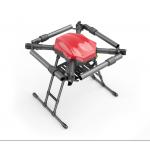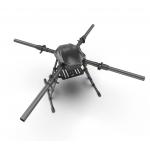Product Background
The rise of the industrial-grade drone market: Compared to
consumer-grade drones, which are mainly used in entertainment and
leisure scenarios, industrial-grade drones have developed rapidly
due to their diverse application scenarios. According to Frost
& Sullivan's prediction, the industrial drones will maintain a
high growth rate from 2020 to 2024, and their market size will
exceed that of consumer-grade drones for the first time, becoming
the main market for civilian drones globally. This has prompted
enterprises to develop large-capacity drones to meet the needs of
industrial-grade applications, thereby promoting the development of
large-capacity drone frames.
Application scenario demand drive: In the field of geological
exploration, the traditional methods of carrying equipment on the
back of people or by horse or renting manned helicopters are
inefficient, costly, and risky. Heavy-duty drones can transport
equipment to remote collection points, improving efficiency and
reducing costs. In emergency fire and rescue operations, in the
face of large-scale disasters in harsh environments outside cities,
such as fires and floods, drones are needed to transport supplies
and ensure communication. Heavy-duty drones can play an important
role. Additionally, in power construction, such as in the
mountainous areas of Zhejiang Quzhou, heavy-duty drones have
successfully lifted over 500 kilograms of transmission tower
materials. These scenarios have placed high demands on the load
capacity of drones, driving the development and application of
large-capacity drone frames.
Technological advancements provide support: The progress in
materials technology is one of the key factors. The application of
aerospace-grade composite materials has enabled the frame to
maintain structural strength while reducing weight, thereby
enhancing the operational capabilities of unmanned aerial vehicles.
At the same time, aerodynamic optimization design of rotors,
improvements in battery and motor technologies, etc., also
contribute to increasing the payload capacity of unmanned aerial
vehicles. Moreover, advanced algorithms and control strategies,
such as the development of multi-point collaborative control
systems, can ensure the stability and safety of multi-machine
synchronous operations, providing technical support for the design
and application of large-load unmanned aerial vehicle frames.
Low-altitude economic development contributes: The rise of
low-altitude economy has gradually revealed the advantages of
unmanned aerial vehicles in various fields such as construction,
rescue, and post-disaster reconstruction. Large-load unmanned
aerial vehicles, as an important component of this, can play a
unique role in these fields. With the continuous development of
low-altitude economy, the market demand is also increasing,
creating a favorable environment for the development of large-load
unmanned aerial vehicle frames.
Replacement of traditional transportation methods: Traditional
transportation methods such as mule and horse transportation,
helicopter transportation, etc., have problems such as low
efficiency, high cost, or significant environmental impact. Large
heavy-duty drones have the advantages of unmanned operation, large
payload, long endurance, environmental friendliness, no need for
large airports and taxiing runways, etc. They can to some extent
replace traditional transportation methods and meet the
transportation needs in specific scenarios, which has also promoted
the development of large heavy-duty drone platforms.
Product parameters
| Developed size | 1905*1720*706mm |
| Folding size | 635*1340*706mm |
Product display











